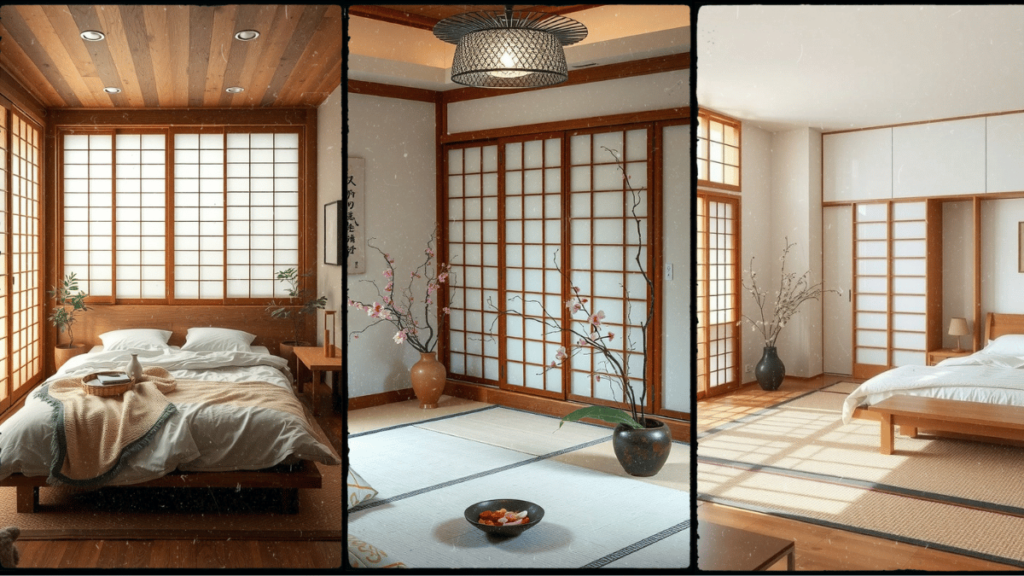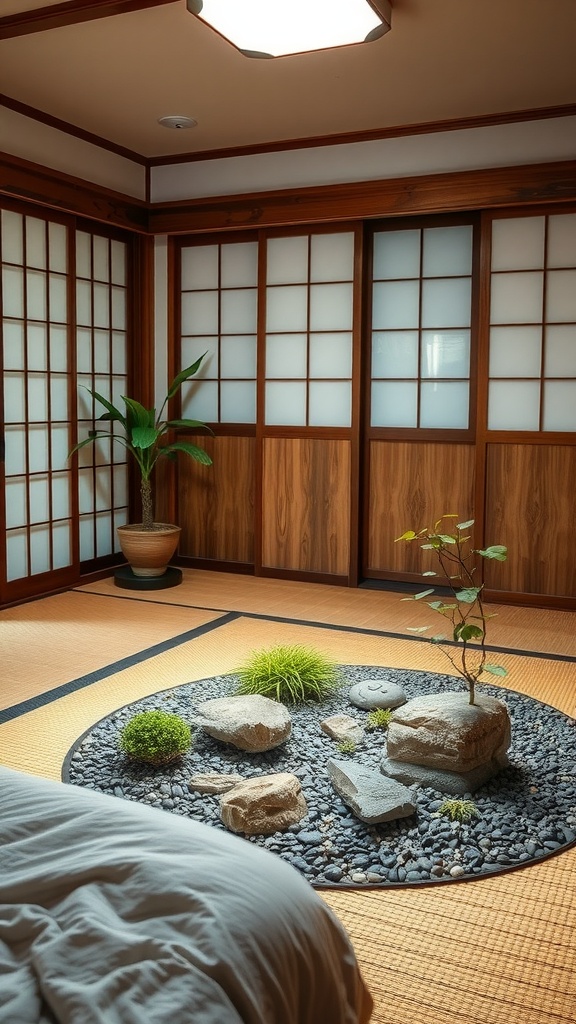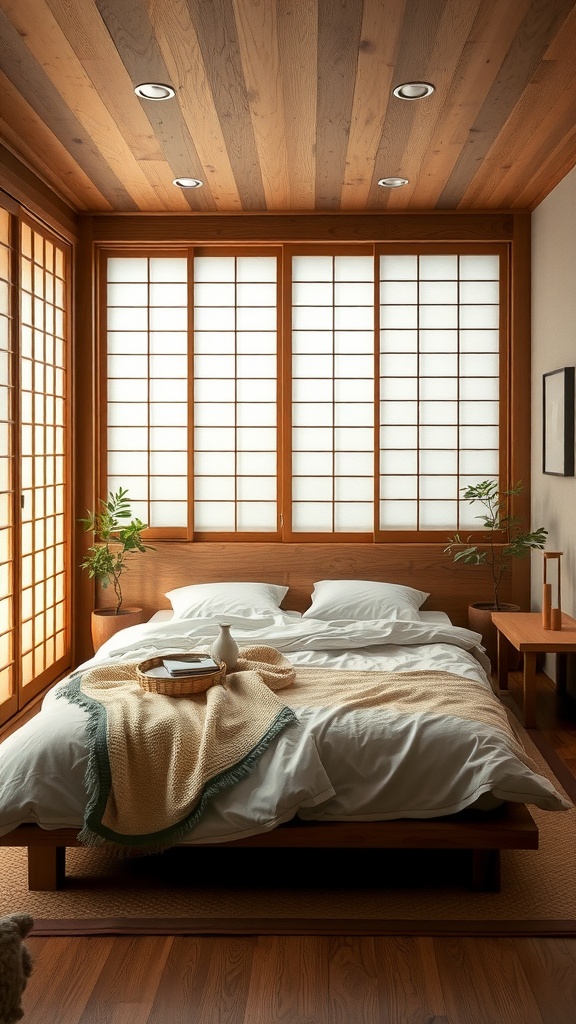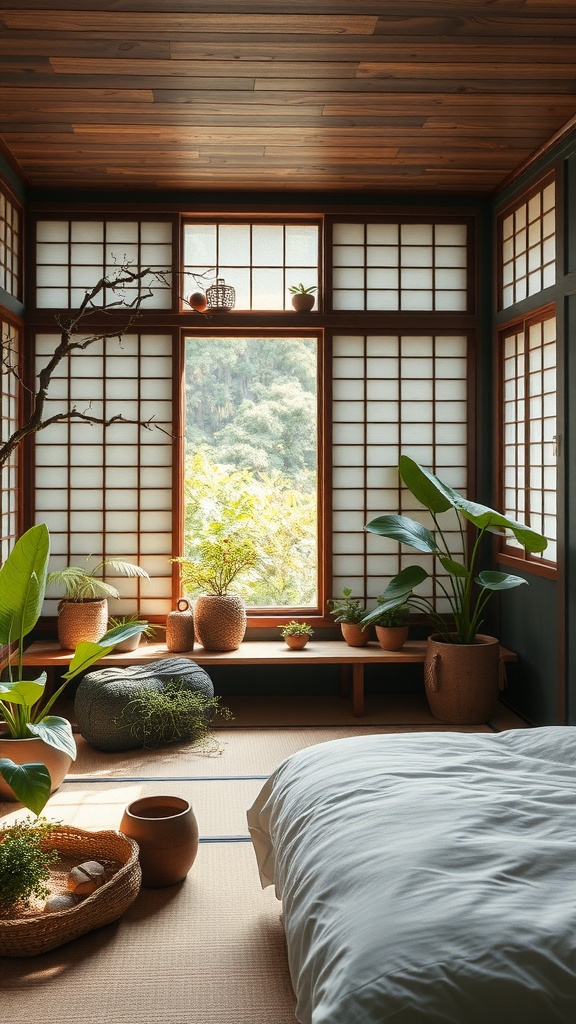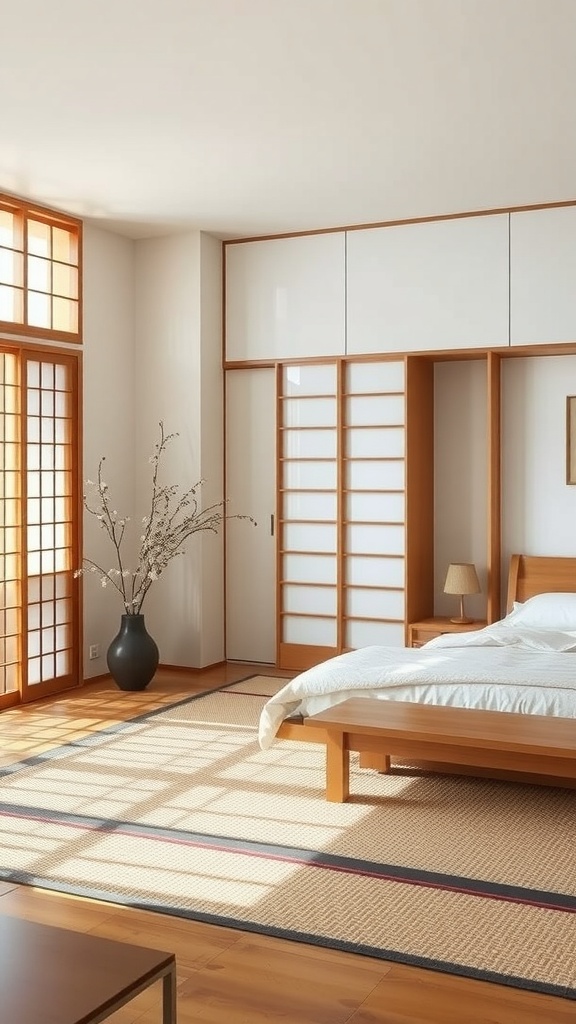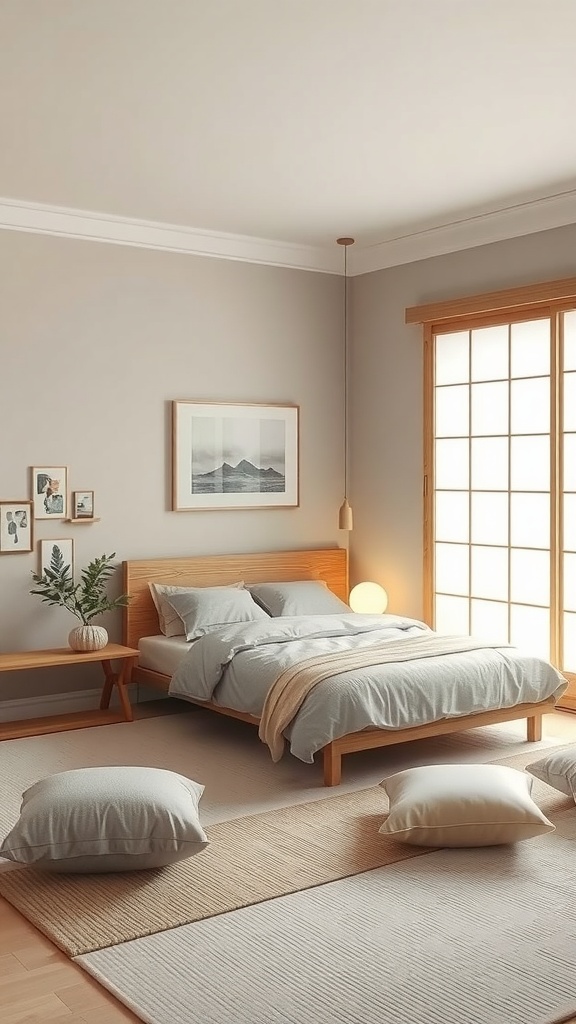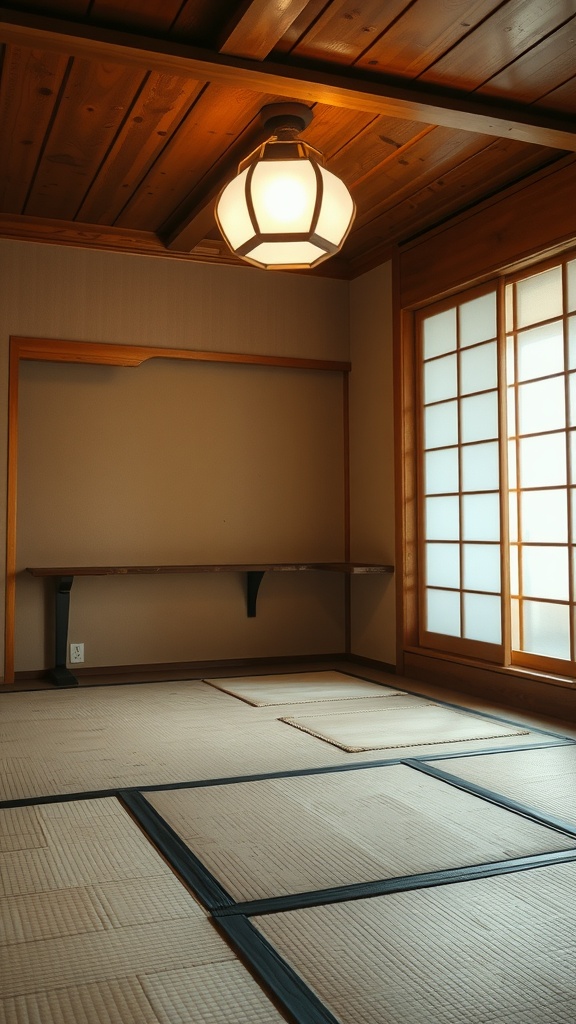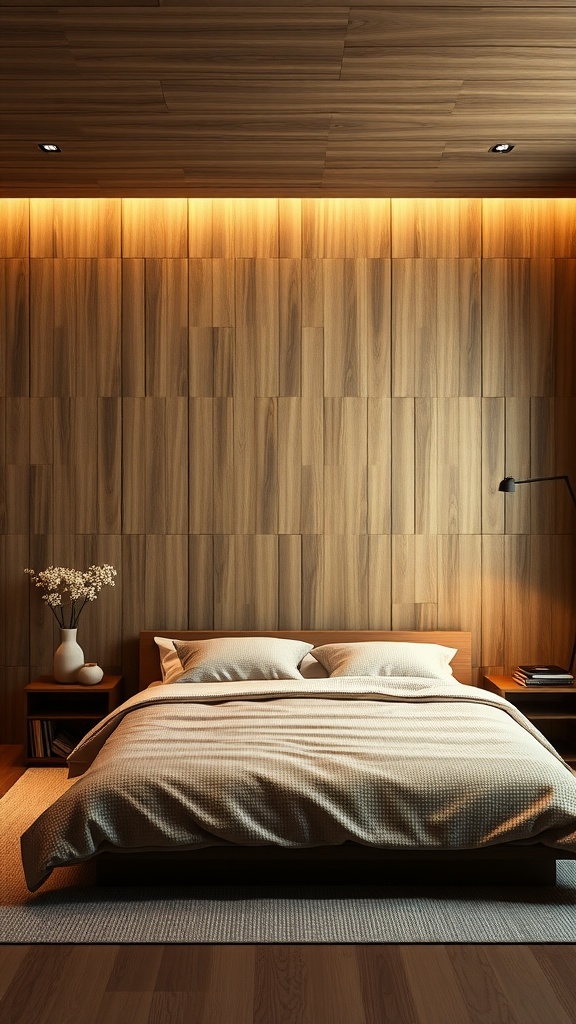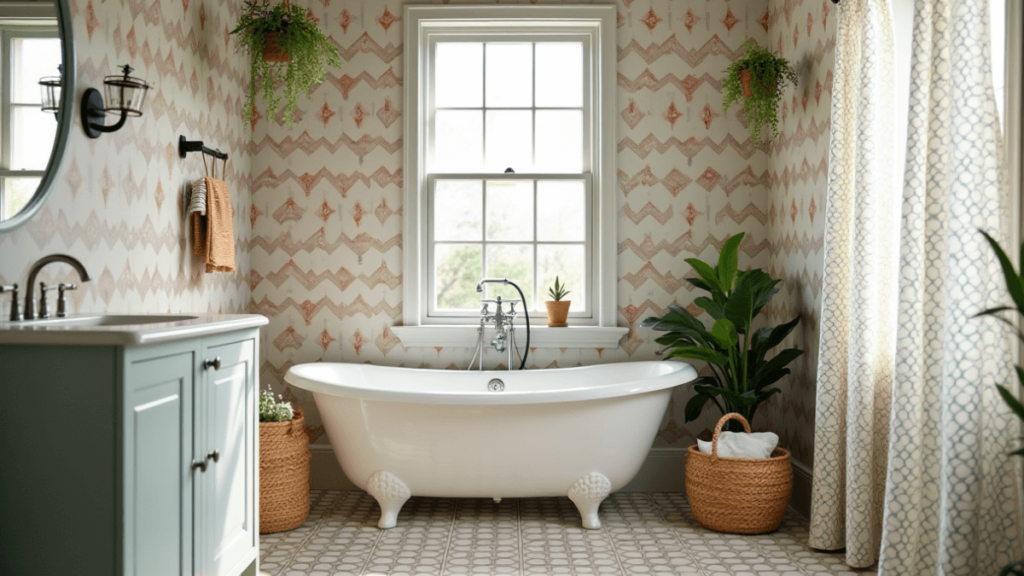Japanese-style bedrooms are all about simplicity and tranquility, making them perfect for creating a peaceful retreat in your home. This guide explores various design ideas that incorporate clean lines, natural materials, and a harmonious aesthetic to help you turn your bedroom into a serene Japanese-inspired space.
Fusuma Sliding Doors
Fusuma sliding doors are a classic feature in Japanese-style bedrooms. These doors are not just functional; they add a unique charm to the space. The intricate designs and elegant woodwork make them stand out.
The image showcases beautiful fusuma doors featuring delicate patterns. The blend of wood and frosted glass creates a warm and inviting atmosphere. This combination is perfect for dividing spaces without sacrificing light.
Incorporating fusuma into your bedroom design can enhance the overall aesthetic. They offer flexibility in room layout, allowing you to create a cozy nook or a more open area. Plus, they can easily match your decor style, from traditional to modern.
Indoor Zen Gardens
Indoor zen gardens bring a slice of tranquility right into your home. This image showcases a serene space that emphasizes simplicity and natural beauty. The soft, earthy tones of the tatami mats paired with the wooden panels create a warm, inviting atmosphere.
In the center, a small zen garden features carefully placed stones, lush greenery, and pebbles that invite you to slow down and reflect. The gentle curves of the garden draw the eye and create a focal point that is both calming and aesthetically pleasing. It’s a perfect spot for meditation or simply taking a moment to breathe.
A potted plant in the corner adds a touch of life, enhancing the natural feel of the room. This design element encourages a connection to nature, which is central to Japanese aesthetics. Indoor zen gardens can transform any bedroom into a peaceful retreat where you can unwind and recharge.
Low-Profile Bed Frames
Low-profile bed frames are a key feature in Japanese-style bedroom design. They enhance the serene and minimalistic vibe that this style is known for.
The image showcases a beautifully crafted low-profile bed. The wooden frame sits close to the ground, making it easy to get in and out of bed. This design creates a sense of openness in the room, which is essential for a tranquil environment.
Soft linens on the bed offer comfort and a cozy feel. The warm tones of the wood in the frame and the flooring complement each other, adding to the overall warmth of the space. The use of natural materials is a hallmark of Japanese design, promoting a connection with nature.
To achieve a Japanese-style bedroom, consider adding accent pieces like a simple nightstand and a few plants, as shown in the image. These elements bring life into the space while keeping the aesthetic uncluttered.
Soft and Natural Lighting
In a Japanese-style bedroom, soft and natural lighting plays a key role in creating a calming environment. The image showcases a serene room that beautifully demonstrates this principle. The large windows allow sunlight to filter in gently, illuminating the space without harshness.
The sliding shoji doors add to the charm, diffusing the light and casting soft shadows that enhance the room’s tranquility. This design choice not only brightens the space but also connects the indoors with nature outside.
Soft lighting can make the bedroom feel more inviting and restful. Using natural materials, like wood and tatami mats, complements this effect beautifully. When designing your own space, consider how light interacts with different surfaces and colors.
Harmony with Nature
In Japanese-style bedrooms, nature plays a key role. The image shows a calm space with ample natural light streaming through shoji screens, which add a soft glow. The view outside frames lush greenery, bringing the outdoors in.
The use of plants, like the potted greenery on the windowsill and the floor, creates a strong connection to nature. This not only enhances air quality but also adds life and freshness to the room. The earthy tones of wood and natural fibers, seen in the ceiling and tatami mats, emphasize a serene and warm atmosphere.
Textures matter too. The smoothness of the stones and the softness of the bedding contrast nicely with the roughness of the wooden elements. This mix fosters a feeling of comfort while still being grounded in nature. A simple, uncluttered design helps maintain focus on these natural elements, making the space a peaceful retreat.
Minimalist Furniture Selection
A Japanese-style bedroom is all about simplicity and tranquility. The image shows a spacious room featuring minimalistic furniture that embodies these principles. The low bed frame, made of light wood, offers a cozy feel while allowing the room to maintain an open layout.
Natural light pours in through the large windows, highlighting the clean lines and soft colors of the room. The use of shoji screens in the background adds an element of traditional design while keeping the space airy and bright. These screens are not only functional but also enhance the aesthetic.
The furniture selection is intentional. A small nightstand holds a simple lamp, providing just enough light without cluttering the space. The decorative touches, like the vase with branches, bring a hint of nature indoors, creating a calm atmosphere.
Choosing minimalist furniture in a Japanese-style bedroom helps cultivate a serene environment. Each piece serves a purpose, emphasizing the beauty of simplicity. This approach not only makes the room more functional but also enhances relaxation and mindfulness.
Neutral Color Palette
A neutral color palette is key in creating a serene Japanese-style bedroom. In the image, soft gray walls blend harmoniously with natural wood tones. This gentle color scheme promotes tranquility, making it a perfect backdrop for relaxation.
The bedding features subtle shades, enhancing the calming effect of the room. A few soft pillows on the floor invite comfort and simplicity, which are essential in Japanese design. The light from the sliding doors adds warmth, highlighting the room’s peaceful vibe.
Incorporating elements like a simple wooden bed and minimal decor further emphasizes the neutral theme. Each piece serves a purpose, avoiding clutter and maintaining a clean look. This bedroom design not only feels spacious but also creates a cozy atmosphere where one can unwind.
Tatami Mat Flooring
Tatami mats are a fundamental aspect of Japanese-style bedrooms, providing both comfort and aesthetic appeal. These mats are made from rice straw and covered with woven rush grass, creating a unique texture that feels great underfoot.
The image shows a serene space with tatami flooring, complemented by warm wooden elements. The soft, natural colors of the mats harmonize beautifully with the wood paneling and light fixtures. This setup promotes a calming atmosphere, perfect for relaxation.
Incorporating tatami mats into your bedroom can bring a touch of Japanese tradition to your home. They are not only practical for sitting and sleeping but also add a sense of simplicity and elegance. Consider pairing them with low furniture to enhance the authentic Japanese aesthetic.
Textured Wall Panels
Textured wall panels can transform your bedroom into a serene Japanese-style retreat. The image showcases a stunning wooden wall that brings warmth and depth to the space. The rich tones of the wood create a cozy atmosphere, perfect for unwinding after a long day.
The panels add a tactile element that invites touch, making the room feel more inviting. This design feature can be a focal point, drawing attention as soon as you enter the room. It’s a simple way to infuse natural beauty into your home.
Consider pairing textured wall panels with soft bedding and minimalist furniture. This combination enhances the overall aesthetic, allowing the wood to shine without overwhelming the space. Remember, the key is to keep things simple while embracing nature’s elements.
Decorative Kintsugi Accents
The beauty of a Japanese-style bedroom often lies in its simple yet meaningful decor. One striking feature is the use of Kintsugi, the art of repairing broken pottery with gold. This technique not only fixes items but also celebrates their history and imperfections. Imagine incorporating Kintsugi-inspired decor into your bedroom.
In this image, notice how the soft colors and natural materials create a calming atmosphere. The wooden accents and minimalistic design enhance the sense of tranquility. A Kintsugi vase or decorative piece can add a unique touch, blending seamlessly with the overall aesthetic.
By choosing Kintsugi pieces, you invite a narrative into your space. Each item reflects resilience and beauty, emphasizing that flaws can become a part of a lovely story. This approach not only elevates your room’s design but also adds a layer of depth and authenticity to your home.
Traditional Ikebana Arrangements
In Japanese-style bedroom design, traditional Ikebana arrangements add a unique touch. These floral displays focus on harmony, balance, and simplicity, reflecting natural beauty.
In the image, we see beautiful branches with delicate pink flowers placed in a ceramic vase. The minimalist style complements the room’s serene atmosphere. The use of natural materials, like the wooden sliding doors and tatami mats, enhances this peaceful setting.
The Ikebana art form is more than decoration; it symbolizes the connection between nature and daily life. It encourages mindfulness and appreciation for the moment, making it perfect for a tranquil bedroom space.
Functional and Decorative Storage
In a Japanese-style bedroom, storage plays a key role in maintaining a serene and organized space. The image showcases a beautifully crafted wooden storage unit, which seamlessly blends functionality with style. The warm tones of the wood create a calming atmosphere, perfect for relaxation.
This storage system has open and closed sections, offering a mix of display and concealment. You can showcase decorative items like plants or artwork while neatly storing essentials like bedding or books. This balance keeps the room looking tidy yet inviting.
The use of natural materials is vital in Japanese design. The wooden texture adds warmth and a sense of nature, which is important for creating a peaceful environment. Consider incorporating similar features in your own space to achieve that perfect harmony between utility and aesthetics.

